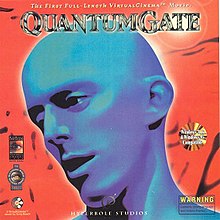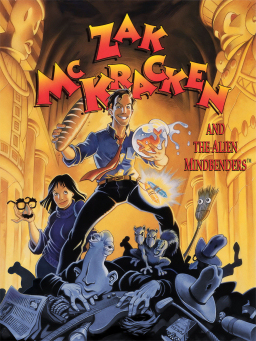
Zak McKracken and the Alien Mindbenders is a 1988 graphic adventure game by Lucasfilm Games. It was the second game to use the SCUMM engine, after Maniac Mansion. The project was led by David Fox, with Matthew Alan Kane as the co-designer and co-programmer.

Star Control: Famous Battles of the Ur-Quan Conflict, Volume IV is an action-strategy video game developed by Toys for Bob and published by Accolade. It was originally released for MS-DOS and Amiga in 1990, followed by ports for the Sega Genesis and additional platforms in 1991. The story is set during an interstellar war between two space alien factions, with humanity joining the Alliance of Free Stars to defeat the invading Ur-Quan Hierarchy. Players can choose to play as either faction, each with seven different alien starships which are used during the game's combat and strategy sections.
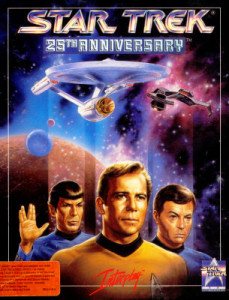
Star Trek: 25th Anniversary is an adventure video game developed and published by Interplay Productions in 1992, based on the Star Trek universe. The game chronicles various missions of James T. Kirk and his crew of the USS Enterprise. Its 1993 sequel, Star Trek: Judgment Rites, continues and concludes this two-game series.

The Journeyman Project is a time travel adventure computer game developed by Presto Studios.
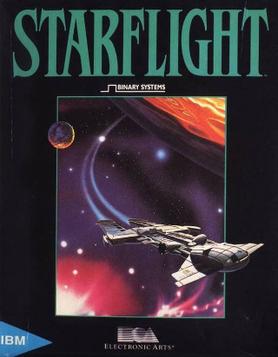
Starflight is a space exploration, combat, and trading role-playing video game created by Binary Systems and published by Electronic Arts in 1986. Originally developed for IBM PC compatibles, it was later ported to the Amiga, Atari ST, Macintosh, and Commodore 64. A fully revamped version of the game was released for the Sega Genesis in 1991.
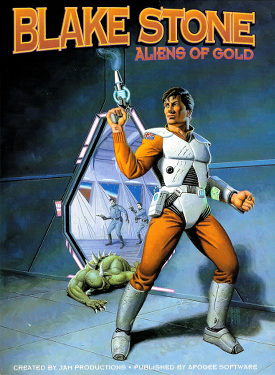
Blake Stone: Aliens of Gold is a first-person shooter for DOS created by JAM Productions and published by Apogee Software on December 5, 1993. The following year, a sequel called Blake Stone: Planet Strike was released, which continues where Aliens of Gold leaves off. Some copies of the game provided a Command Control Gravis Gamepad.

Frederik Pohl's Gateway is a 1992 interactive fiction video game released by Legend Entertainment, and written by Glen Dahlgren and Mike Verdu. It is based on Frederik Pohl's Heechee universe. It was followed by a sequel Gateway II: Homeworld, in 1993.
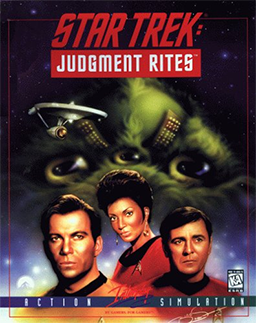
Star Trek: Judgment Rites is a computer game first produced by Interplay Productions in 1993, featuring the original cast of the classic Star Trek in a series of new adventures, including one featuring Trelane, the omnipotent child from the original episode "The Squire of Gothos". Judgment Rites uses the same MS-DOS game engine as the earlier Star Trek: 25th Anniversary; however, it had sharper graphics and sound, particularly with the CD-ROM edition. All of the initial cast members provided voices for their characters on the game in that edition. William Campbell also reprised his guest role as Trelane.

A Stargate is a fictional Einstein–Rosen bridge portal device within the Stargate fictional universe that allows practical, rapid travel between two distant locations. The devices first appeared in the 1994 Roland Emmerich film Stargate, and thereafter in the television series Stargate SG-1, Stargate Atlantis, and Stargate Universe. In these productions, the Stargate functions as a plot device, allowing the main characters to visit alien planets without the need for spaceships or any other type of technology. The device allows for near-instantaneous travel across both interstellar and extragalactic distances.
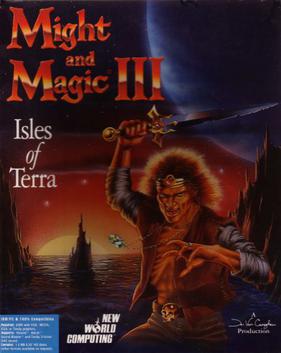
Might and Magic III: Isles of Terra is the third game in the role-playing video game series Might and Magic. Released in 1991, it is the predecessor to Might and Magic IV: Clouds of Xeen and the sequel to Might and Magic II: Gates to Another World. A Sega Genesis version was developed, but never released.

Kabuki: Quantum Fighter is a 2D platform game developed by Human Entertainment and published by HAL Laboratory for the Nintendo Entertainment System. It was originally released on December 21, 1990, in Japan and was released in January 1991 for the North American market before being released in Europe on February 20, 1992.

Rama is a first-person adventure game developed and published by Sierra On-Line in 1996. The game is based on Arthur C. Clarke's books Rendezvous with Rama (1973) and Rama II (1989) and supports both DOS and Microsoft Windows. In 1998, a PlayStation version was released in Japan. It is the second Rama game to be produced. The interactive fiction game Rendezvous with Rama was released in 1984 by Telarium.
The Star Fleet computer games are starship tactical combat simulations originally created by Dr. Trevor Sorensen in the late 1970s.

XF5700 Mantis Experimental Fighter is a space combat simulator developed by Paragon Software and published by MicroProse under their Microplay Software label for DOS in 1992.

Mission Critical is a sci-fi adventure game, created by Legend Entertainment for MS-DOS, written by the company's CEO Mike Verdu, and released in November 1995. The game consists of 3D graphics and features live-action scenes, with the cast including Michael Dorn and Patricia Charbonneau. The games storyline focuses on the player taking on the role of a single crew member, who is left behind on their ship after their captain feigns a surrender to ensure a vital mission can continue. The player's goal focuses on repairing their ship after a recent battle, and then getting to the surface of a planet to complete a secret scientific mission that could provide the means to ending a war over technological advancements and artificial life.
The planetary systems of stars other than the Sun and the Solar System are a staple element in many works of the science fiction genre.

Supreme Commander: Forged Alliance is a stand-alone real-time strategy video game released in November 2007 as the expansion to Supreme Commander. The second title in the franchise, it was similarly developed by Gas Powered Games and published by THQ.
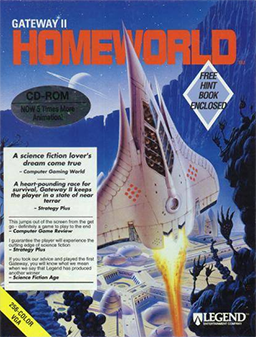
Gateway II: Homeworld is a 1993 interactive fiction video game developed and published by Legend Entertainment. The sequel to Gateway (1992), it is set in Frederik Pohl's Heechee universe.
Independence Day is a franchise of American science fiction action films that started with Independence Day in 1996, which was followed by the sequel, Independence Day: Resurgence in 2016. The franchise revolves around extraterrestrials invading Earth and seeking to eradicate mankind while the remaining human resistance uses everything at their disposal to defeat the invaders and take back the planet. Now considered to be a significant turning point in the history of the Hollywood blockbuster, the original film was released worldwide on July 3, 1996, but began showing on July 2 on limited release as a result of a high level of anticipation among moviegoers. The film grossed over $817.4 million worldwide, becoming the highest-grossing film of 1996 and, briefly, the second-highest-grossing film worldwide of all time behind 1993's Jurassic Park. Currently, it ranks 69th on the list of highest-grossing films, and was at the forefront of the large-scale disaster film and sci-fi resurgence of the mid-late 1990s. The film won the Academy Award for Best Visual Effects and was nominated for the Academy Award for Best Sound Mixing.
